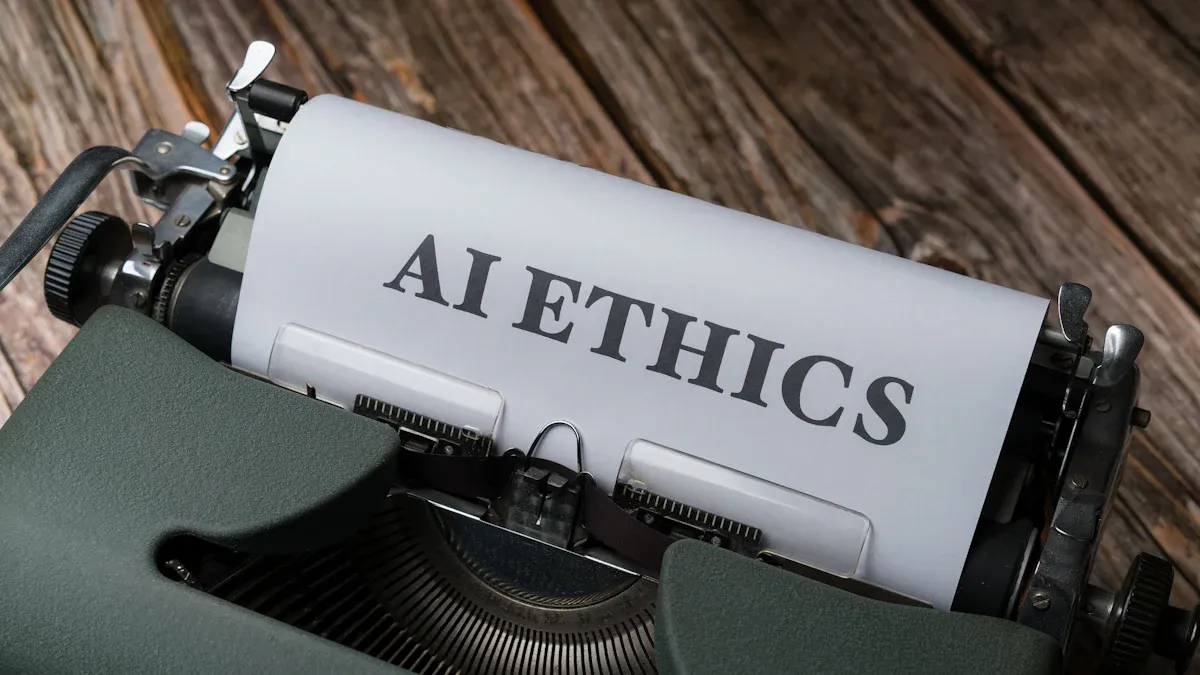Building Trust with Ethical AI Content Practices

Organizations build trust by focusing on transparency, fairness, explainability, and accountability. Building trust is essential as customers demand clear messages and ethical guidelines. Trust in AI has become more critical than ever before. For example:
The number of companies with an ethical AI charter increased from 5% in 2019 to 45% today.
Over 70% of customers want AI to be clear and easy to understand.
Nearly half of consumers share their negative AI experiences with others.
People build trust in companies when they openly explain how AI works. These efforts in building trust protect the brand and encourage more people to use their products. Explainability also helps companies meet public expectations for trust.
Key Takeaways
Being honest about how AI works helps people trust it. It also makes people feel safe when they use it. People need to watch AI and guide it. This helps find mistakes and keeps AI fair. It also makes AI more reliable. Companies should take care of what AI does. This helps them earn respect and follow rules. Checking AI for bias is important. Protecting user privacy is important too. These things make AI fairer and help people trust it. Giving clear reasons for AI choices helps users understand AI. It also helps them trust AI more.
Building Trust

Transparency
Transparency is very important for trust in AI content. When organizations are open, people can see how AI works. This helps more people use and accept AI in different areas. For example, Meta’s open-source Llama language models let researchers check for bias and toxicity. This way, people can hold companies responsible and help make new ideas. It also helps follow laws and fix fairness problems.
Transparency matters more as more groups join things like the Partnership on AI’s Synthetic Media Framework. These groups share case studies and use labels to show when content is made by AI. These steps help people know when AI is used and who is responsible.
Transparency reports and simple talks about how AI makes choices help users trust AI. When companies share where data comes from and how models work, they show they are responsible and follow rules. Audits check if companies keep being open and honest. These actions make people feel safe and build strong connections.
Human Oversight
Human oversight is needed to build trust in AI content. AI cannot make good choices about right and wrong or understand feelings. People add the care and understanding that AI does not have. For example, the Uber self-driving car accident showed that humans can stop bad things from happening. Generative AI makes mistakes, so people must fix them to keep quality and customers happy.
Human oversight means checking training data and methods before using AI.
Risk checks and clear rules stop AI from running without control.
Committees and audits help keep watch over AI.
Outside experts can check if rules and data are good.
The White House’s AI Bill of Rights says to use fair data, check for fairness, and keep watching AI to stop unfair results. These steps help AI stay fair and trusted. But some studies say only using human oversight may not stop all mistakes. Oversight by groups, with proof and public review, can give better safety.
Accountability
Accountability is the base of good AI practices. The NTIA Artificial Intelligence Accountability Policy Report shows many people care about accountability in AI. The government asks AI makers to follow rules and takes action to make sure they do. The Biden Administration’s Executive Order on trustworthy AI also says accountability is important.
A PractiTest survey found that 86% of people think the government should control AI companies. This shows people really care about accountability and ethics in AI. The Responsible AI Institute’s RAISE Benchmarks help companies use good AI rules. These rules check for risks, like mistakes in large language models, and make sure companies follow ethical AI.
Good communication and strong rules make people trust AI more. Letting people report bad behavior helps everyone act responsibly. Being open about choices and problems builds trust and meets what people expect. Companies that care about accountability get good workers, follow rules, and are ready for hard times.
Trust in AI content needs transparency, human oversight, and accountability. These things help people feel safe and help companies do well for a long time.
Best Practices for Ethical AI
Bias Mitigation
Bias in AI can cause unfair results and hurt trust. Groups must look for data bias at every step. Fixing bias is a key part of ethical ai. Teams check data often to find and fix unfair patterns. For example, a healthcare tool once helped white patients more than Black patients. It used money spent on care to decide who needed help. After fixing bias, more Black patients got extra care. The number went up from 17.7% to 46.5%. This shows that ethical steps can make real life better.
Studies show that fixing bias stops unfair results, especially for protected groups. Teams use different ways to do this:
Pre-processing means changing data before training to lower bias.
In-processing means changing the model during training to fix bias.
Post-processing means changing results to make things fair.
A team with many skills works best. Teams should have ethicists, social scientists, and experts. Different people can see bias that others miss. Human-in-the-loop systems let people check and fix AI choices. These steps help use ai in a good way and match ethical rules.
Checking AI often and sharing reports keeps things fair. Companies that do this build trust and follow ethical rules.
Privacy
Keeping user privacy safe is very important for ethical ai. AI uses lots of data, so strong privacy rules are needed. Some ways help keep data safe:
Federated learning trains models on data that stays with users.
Differential privacy adds noise to data so it is hard to trace.
Homomorphic encryption lets AI use encrypted data without seeing details.
Secure multi-party computation lets groups work together without sharing private data.
Aspect | Details |
|---|---|
Frameworks Covered | Federated learning, differential privacy, homomorphic encryption, secure multi-party computation |
Industry Sectors | Healthcare, finance, technology |
Market Size & Forecast | Valued at USD 4.6B in 2024; expected USD 49.2B by 2037; CAGR 20% (2025-2037) |
Key Technologies | Secure enclaves, confidential computing, Intel SGX-based platforms |
Applications | Secure transactions, fraud prevention, data-swapping in banking, insurance, healthcare |
Growth Drivers | Adoption in financial services for secure multi-party computation enabling joint fraud pattern analysis |
Privacy rules protect users and help companies follow laws. Watching and updating systems keeps data safe. These steps show respect for users and build trust for a long time.
Inclusivity
Inclusivity makes sure AI works for everyone. Teams that care about inclusivity make better products and reach more people. When companies teach all workers to use AI, more people use it. For example, 84% of women in tech who get training use generative AI. This is higher than other groups. This shows that being inclusive helps more people use AI.
Metric / Group | Women Overall | Men Overall | Women in Tech Industry | Men in Tech Industry |
|---|---|---|---|---|
Company Encouragement to Use Gen AI | 61% | 83% | 84% | N/A |
Company Provides Training on Gen AI | 49% | 79% | 72% | N/A |
Using Gen AI for Projects/Tasks | N/A | N/A | 44% | 33% |
High or Very High Trust in Data Security | 18% | 31% | >40% | >40% |
Agreement Benefits Outweigh Privacy Concerns | 54% | 60% | 75% | 75% |
Surveys and stories show that different teams lower bias and help new ideas grow. For example, Microsoft’s Seeing AI app was made by a team with people with disabilities. This helped make a tool for people who cannot see well. Inclusivity helps ethical ai by making sure AI fits many needs.
Teams that include everyone make AI more fair and strong. These steps help groups follow ethical rules and use best practices for ethical ai.
Explainability in AI

AI Explainability
Explainability is very important for ethical AI. Companies need explainability to earn trust and follow rules. Laws like the EU AI Act, GDPR, and CCPA say AI must be explainable. These laws want AI to be open, fair, and easy to check. Just being accurate is not enough for these rules. Explainability lets people know why AI made a choice, like why someone did not get a loan or how a doctor used AI to find a sickness.
Explainability helps manage risks by keeping records and showing reasons for choices.
It helps developers fix problems and follow the law.
Different people need different explanations, so some are simple and some are detailed.
Explainability helps people trust AI, including customers and rule-makers.
Better explainability, like counterfactual state explanations, proves fairness. These show that only important things change decisions. This matches fairness laws like GDPR Article 22 and the US Equal Credit Opportunity Act. This way, companies follow the rules and act ethically.
Teams should start explainability early when making AI. They should write down how the system works and what it needs to explain. Tools that track where data comes from help connect new ideas with following the rules. Explainability also keeps companies safe from money loss and bad reputations.
Interpretability
Interpretability works with explainability to help people understand AI. Studies show that when people understand AI, they use it more. If users get clear answers, they trust AI and want to use it. Research says that good explanations make people less afraid of AI and more willing to try it.
Explaining AI mistakes helps people trust it more.
Interpretability lets people depend on AI when they see how it works.
If AI is hard to understand, people would rather ask a person for help.
There are many ways to make AI easier to understand:
Show each step in how AI makes choices.
Use pictures or charts to explain how data moves.
Give real-life examples, like comparing AI to a smart thermostat.
Point out helpful things, like saving time or money.
Give guides, word lists, and FAQs to help users.
A table can show main explainability strategies:
Explainability Strategy | Description |
|---|---|
Simple Language | Uses easy words and examples |
Step-by-Step Breakdown | Shows each step from input to output |
Visual Aids | Uses pictures and charts for clarity |
Real-World Examples | Links AI to things people know |
User Documentation | Gives guides and FAQs for help |
Some AI models, like decision trees or rule-based systems, are easy to explain. Other tools, like LIME or SHAP, help explain more complex AI. Mixing AI with human checks keeps things safe and trusted. Tools like partial dependence plots and saliency maps help people see how AI works.
Explainability and interpretability together make AI open, fair, and trustworthy. These things help more people use AI and help companies follow the rules.
Ethical Practices and Regulation
Governance
Good governance is the base of responsible AI. Companies make ethical rules and check them often for new risks. Getting feedback from workers and users helps find problems early. Big companies like Microsoft and IBM have ethics boards. These boards look at AI projects for fairness, privacy, and transparency. They meet often and use tools to spot bias and make AI better.
Teams can fix problems fast with regular reviews and feedback. Google uses its Advanced Technology Review Council to check risky AI projects. They also get feedback from many groups.
Here is a table that shows how governance builds trust in AI:
Statistic | Description | Implication for AI Governance |
|---|---|---|
Nearly 50% of enterprise leaders | Investing more in responsible AI in 2024 than ever before | Shows growing focus on governance for trust |
31% of business and tech leaders | Expect generative AI to transform their organizations soon | Highlights need for strong governance |
8% erroneous data injection | Can reduce AI accuracy by 75% | Proves governance is key to reducing risk |
Checking for risks, having different team members, and open feedback help keep AI safe and fair. These steps help make sure AI systems are trusted and work well in the future.
Compliance
Compliance means following rules and standards for AI. Many companies update privacy and governance rules when using AI. They check for risks and use tools to find bias and keep data safe. Companies that follow compliance rules have fewer problems and build more trust.
AI helps find non-compliant actions 40% more accurately (Deloitte).
Businesses using AI fully have 33% more confidence in following rules (PwC).
57% of companies use AI for risk and compliance (McKinsey).
68% of businesses spend on AI ethics for more accountability and transparency (World Economic Forum).
90% of financial services compliance officers say AI is key for meeting rules (IBM).
59% of leaders say AI helps find risks and bad actions (PwC).
Standards like ISO/IEC 42001 and the NIST framework help companies check AI steps, look for bias, and keep things clear. The EU AI Act says high-risk AI must have clear checks and accountability. Comparing compliance programs to these standards helps companies find and fix weak spots. Checking and updating rules often keeps compliance strong as laws change.
Companies that care about compliance protect privacy, lower risks, and get ahead of others. These steps make compliance helpful, not just a rule to follow.
Ethical practices are the main way to build trust in AI content. Groups that care about transparency, fairness, and explainability do better over time. They get more trust from people and follow the rules. Stories show that explainability and responsibility help groups look honest. Teams make explainability better by checking for bias, working with different people, and listening to feedback. Checking explainability often and holding user workshops help find problems and make things fair. Tools for explainability and clear talks help users know why choices are made. When groups use explainability, transparency, and fairness, people trust them more and see ethical AI as a smart choice.
FAQ
What is the importance of transparency in building trust with AI?
Transparency lets people see how AI works. When companies share clear reports, people trust them more. Open talks about AI show companies act responsibly. This makes people feel safe and shows good ethics. Being open helps everyone trust AI and follow the best rules.
How do organizations address data bias in AI systems?
Teams check for bias by looking at risks and watching data often. They use explainability to see how AI makes choices. Having different people on teams helps find and fix bias. These actions make AI fairer and help people trust it more.
Why does explainability matter for AI in healthcare?
Explainability helps doctors and patients know how AI decides things. This makes people trust AI and keeps things fair. It also helps hospitals follow important rules. Explainable AI makes sure everyone feels safe using it.
What role does accountability play in AI governance?
Accountability means companies must act in the right way. Good AI rules include checking work and getting feedback. This helps people trust AI and makes sure companies are open. Being accountable helps AI stay fair in the future.
How can companies prepare for the future of ethical AI?
Companies should watch AI closely and be open about how it works. They need to update their rules and listen to others. Using explainability and thinking about ethics helps build trust. These steps help companies follow new laws and do the right thing.
See Also
Achieving SEO Excellence Using Perplexity AI Techniques
Writesonic AI And QuickCreator Battle For Content Supremacy
Strategies To Analyze Content And Beat Your Competition

